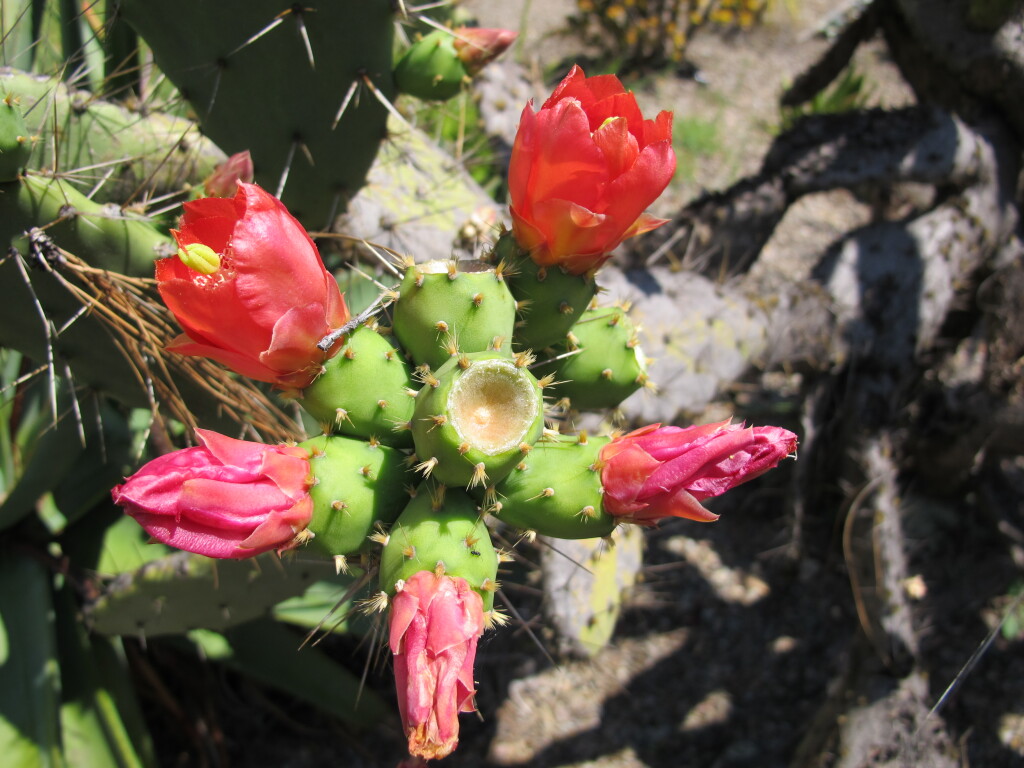Opuntia elatior
Mill. Red-flower Prickly-pearErect shrub 2–5 m high, trunk well-developed, to c. 170 cm high in older plants, c. 15 cm diam., plants to 8 metres across Terminal cladodes compressed, obovate to elliptic, 28–40 cm long, 6.5–20 cm wide; light grey-green, often glaucous, smooth; margins sinuate; areoles 15–35 per cladode face, (1.5–)3–5 cm apart, filled with pale yellow-brown glochids and pale brown wool; spines 2 or 3, to 4.5 cm long, to 1 mm wide near base, pale yellow-brown, ageing to grey-brown, erect, spreading or deflexed. Flowers 3–5 cm diam., sepaloids reddish-green, petaloids erect, bright red; filaments pale yellow below, crimson above; anthers pale yellow; hypanthium obovoid, smooth, weakly tuberculate, apex depressed; style crimson, stigma green. Fruits sterile, barrel-shaped to obovoid, 1.8–3.5 cm long, 2.3–3 cm diam., tuberculate, carmine, persistent, not proliferous. Flowers late spring–summer.
VVP. Also WA, NT, SA, Qld, NSW. The natural distribution of Opuntia elatior is uncertain, most likely Colombia and Venezuela, with records from the Carribean and central America perhaps been more recent introductions (Pasiecznik 2015). Naturalised at Studley Park, Kew, where probably originally introduced as an ornamental planting (but record not substantiated by specimens).
It is unclear whether more than one taxon is encompassed under Opuntia elatior in Australia. Britton and Rose (1919) treated O. bergeriana and O. elatior as separate species, differentiated on the basis of the narrowly oblong and somewhat glaucous stem-segments, and deep red flowers in O. bergeriana, compared with the obovate to oblong or suborbicular, olive-green stem segments, and dark yellow flowers tinged red or sometimes salmon-rose in O. elatior. Innes and Glass (1991) recognised O. bergeriana, but most authors regard O. bergeriana as a taxonomic synonym of O. elatior (e.g. Anderson 2001; Hunt et al. 2006). Stajsic and Carr (1996) recognised O. bergeriana (with reservation) on the basis that the plants known in Victoria differed from the description in Telford (1984) in having grey-green cladodes and deep red flowers, and not having green stem segments and orange-pink flowers. At least some of the plants referred to as O. elatior in Australia also tend to have a greater number of spines per areole compared with 'O. bergeriana'. There is also the possibility that another species might be involved. Although Hunt et al. (2006) treat O. bergeriana as a synonym of O. elatior, they do however, provide separate descriptions for them. The species is treated in a broader sense here pending taxonomic resolution.
 Spinning
SpinningAnderson, E.F. (2001). The Cactus Family. Timber Press.
Britton, N.L.; Rose, J.N. (1919). The Cactaceae: Descriptions and illustrations of the plants of the cactus family, edn 1st. The Carnegie Institute of Washington, Washington.
Hunt, D.; Taylor, N.; Charles, G. (2006). The new cactus lexicon (text). dh books, England.
Innes, C.; Glass, C. (1991). The illustrated encyclopedia of cacti. Simon Schuster, Australia.
Stajsic, V. (2020). . In: Kodela, P.G., Flora of Australia, pp. –. Australian Biological Resources Study, Canberra.




